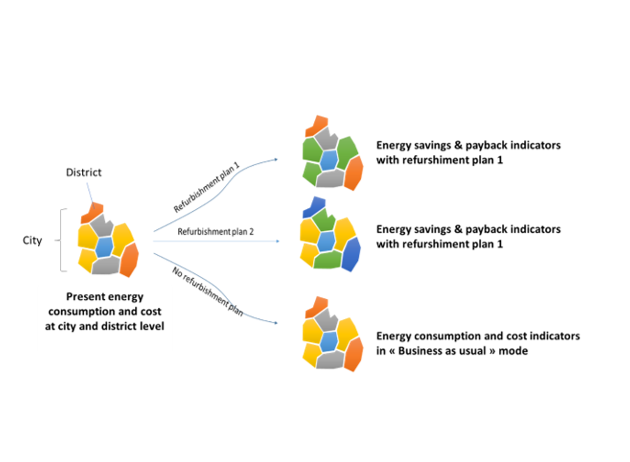CROCUS tool to select a refurbishment plan
Software outputs: Performance Indicators (KPIs) as of today and for different refurbishment plans
What is CROCUS?
CROCUS is a prototype expert tool that simulates the energy consumption per end-use (lighting, heating, etc) of a city, optimizes district heating, and provides cost/benefit analysis of different refurbishment strategies. The tool aims at helping the technical departments of cities in their planning of long-term refurbishment plans.
CROCUS is developed by TECHNOFI, CSTB and RISE, combining several ‘software bricks’:
- The simulation of buildings’ energy consumptions (DIMOSIM module by CSTB), based on the buildings characteristics and occupancy statistics,
- The optimisation of the district heating operation according to the geographical distribution of heat demand (Friendly SAM module by RISE - Open Source software downloadable here),
- The economic analysis of different retrofitting strategies (modules developed by Technofi).
Two levels of retrofitting simulated
Two levels of retrofitting strategies are simulated -at full-city and at district scale-, and compared with a “business as usual” case:
- “light renovation”: targeting the energy consumption values set by the current regulation on new buildings
- “deep renovation”: targeting the energy consumption values set by the most ambitious renovations projects currently identified
In both cases, renovation is focused on improving the building envelope. For each strategy, different refurbishment rates can be simulated (i.e. the percentage of renovation per year). Different scenarios for the future are also considered with regard to the long-term evolution of energy prices, technology costs, e-vehicles deployment, etc.
Software outputs should help decision making
As major output, CROCUS provides a cost/benefit analysis comparing the investment cost of the retrofitting strategies, the related potential energy and CO2 savings to be achieved, and associated economic gain.
Next steps: social parameters and potential for PV
Additional modules are planned for development in order to integrate:
- The estimated potential for local photovoltaic electricity generation,
- Some social parameters such as the acceptance of inhabitants towards retrofitting.
